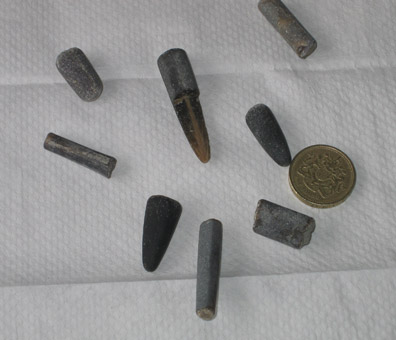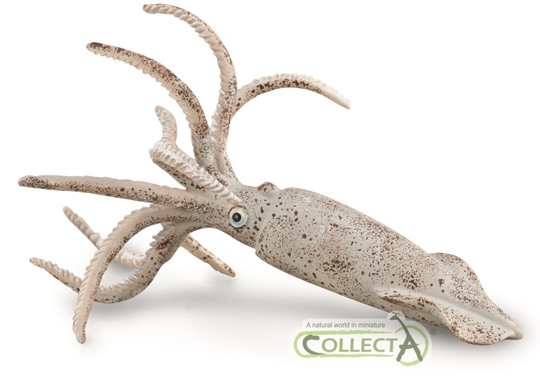Blogging on a Beautiful Belemnite
Belemnites – an Introduction to the Joys of Fossil Hunting
For many people a fossilised rostrum of a belemnite found on the shoreline, washed out of Mesozoic marine sediments is their first fossil find. The bullet shaped fossils are easy to distinguish and often occur in large concentrations within fossil bearing strata.
Belemnites are extinct cephalopods, related to the ammonites and although they superficially resemble squid they are more closely related to extant cuttlefish. Many hundreds of different species are known, most are classified according to subtle differences in the shape of the rostrum (otherwise known as the guard). Guards can be quite pointed, rounded or almost blunt at the rear end and it is these differences that enable scientists to identify various genera. The word belemnite (pronounced Bell-em-night), is derived from the Greek for dart or javelin. Looking at the fossilised calcite guards of these animals it is quite easy to see why.
Various Belemnite Fossilised Rostra from Southern England

Picture credit: Everything Dinosaur
The picture above shows various belemnite guards collected by Everything Dinosaur team members at Charmouth on the Dorset coast and at Ravenscar near Whitby on the Yorkshire coast. The pound coin is shown for scale (I wonder if I will get it back)?
The large belemnite fragment in the centre has been split to show the calcite internal structure. These types of fossils are very robust and are often transported away from their original sediments, washed out of marls and ending up in gravel beds and such like. Belemnite fossil fragments such as these have been known to turn up in Quaternary dated river gravel sediments.
Belemnite
The numerous fossil belemnite guards we placed in the fossil hunting trays at our recent exhibition at the World Museum at Liverpool, proved extremely popular. With many young people able to take home their own fossil of a belemnite guard. Due to their abundance in some marine strata, belemnites can also be used by palaeontologists and geologists to date layers of rock, but ammonites often prove more effective key fossils as they have more diverse forms. Certainly, the basic belemnite body plan seems to have been a very successful design as these animals evolved few variants on this body plan throughout late Palaeozoic right through to the end of the Mesozoic.
Unlike ammonite remains, scientists have been able to find preserved soft body tissue of belemnites and we therefore have a very good idea of what they actually looked like. In very fine grained sediments in Wiltshire (England), and at the famous lithographic limestone beds of Solnhofen in Germany a number of fossils of belemnites have been found with traces of their soft body parts visible. Solnhofen is particularly famous for fossils of the ancient bird Archaeopteryx, but this part of southern Germany has produced a huge number of fossils both vertebrate and invertebrates are represented. The main fossil bearing strata are around the towns of Eichstatt, Kelheim and Solnhofen and to date some 360 different species of belemnites have been identified along with numerous fossil plants and vertebrates including fish, crocodiles, turtles, ichthyosaurs, pterosaurs and even dinosaurs.
The Late Jurassic of Europe
During the Late Jurassic much of this part of Europe was covered by shallow seas and the Solnhofen deposits represent the bed of a shallow, still lagoon. The bed of this lagoon could not support life, so that if animals and plants were washed out into the water, they sank to the bottom and were not scavenged, permitting almost intact specimens to be preserved. The very fine sediments and the still, anaerobic conditions enabled a great deal of detail to be preserved such as the arms and other soft tissues of belemnites that must have been washed into the lagoon from the open sea.
It is from these fossils that scientists have calculated that belemnites had ten equally sized arms, with hooks to grab and secure prey on them. They had beak-like mouths, large eyes and there is some fossil evidence to suggest they possessed ink sacs like modern squid.
A Replica of a Belemnite
To view a model of a Jurassic belemnite and other prehistoric animal invertebrate replicas in the CollectA model range: CollectA Prehistoric Animal Models and Figures.
Belemnites were preyed upon by a number of animals including small marine crocodiles, pliosaurs and ichthyosaurs. Indeed, many small ichthyosaur fossil skeletons have hundreds of belemnite hooks preserved in the area where the stomach would have been. It is thought that these animals vomited up the indigestible parts of the belemnite.


